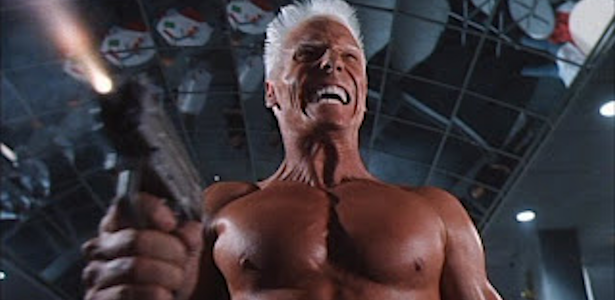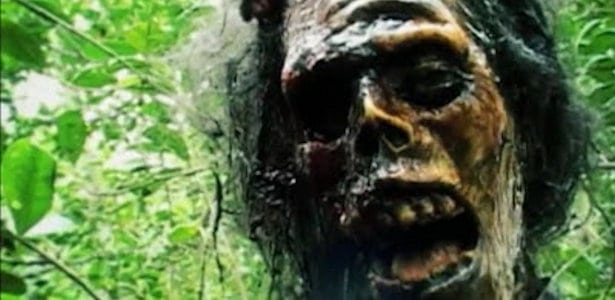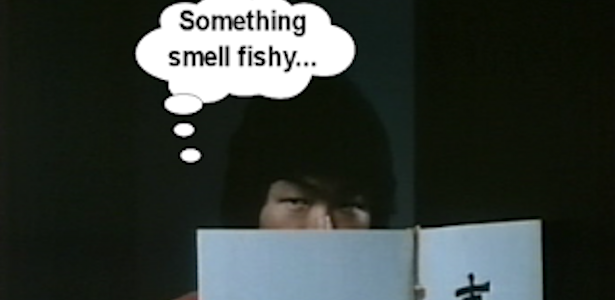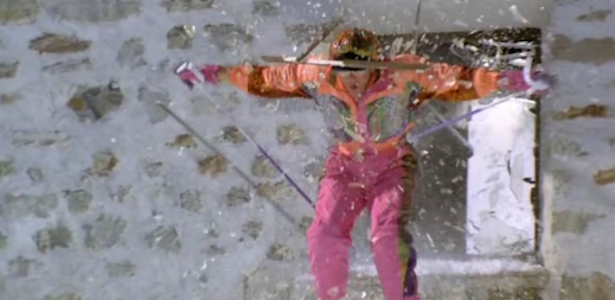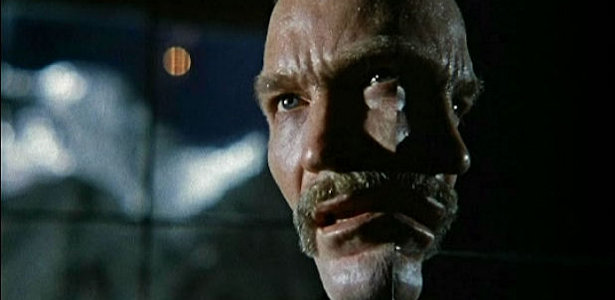The '80s were an interesting time to live in. Ultra-modern society was starting to show cracks, dividing the rich, coke-snorting mega-corporations from distressed lower classes who were the guinea pigs in Reagan's idea of pushing all of the financial gains on to the wealthy so they could occasionally urinate it down the unwashed masses' backs, causing tuppence to occasionally "trickle down" (still a popular idea to this day). When forced with financial hardships the common masses tend to seek catharsis through art. In other words, movies get violent. The violence in films also is a reflection of real life trauma. Snipers in clocktowers, The Zodiac Killer, presidential assassinations, even precedent setting court cases can all contribute to trends in film. Which brings us to this nasty little gem. It may not really know what it's trying to say about all this sociopolitical stuff, but dammit, it's trying to say something!
Deborah Ballin (Lee Grant) is a news pundit who engages in wildly emotional attacks on a legal team involved in a highly publicized homicide of an allegedly abusive husband, by his wife. Her opinionated oral frothing actually predates modern "journalism" and in conjunction with some sort of unfocused feminism (I'm not sure what exactly the point is that is attempting to be made) catches the attention of a man, Colt Hawker (Michael Ironside), who is clearly feeling the stress of the modern age. You know he has issues as he is constantly squeezing a black stress-ball and breathing heavy. He wastes no time in finding Ballin's home address (a mansion in NY - the news biz must be paying good money in those days) and attacking her from a closet, shirtless, sweaty and covered in make-up and jewelry! I believe in technical medical parlance that would be referred to as "coo-coo for cocopuffs".
Hawker has covered his studio apartment walls with letters that he has sent out to all sorts of authority figures, hating on everyone from blacks, Hispanics, women, and the old classic favorite, the Jews. As we find out later on in the film, this is a result of a '50s upbringing with a drunken father who used to wrestle with him on the grass and pour alcohol on his face. Oh, and when dad tried to rape mom, she threw hot oil on his face. What do you mean "that's it?" Isn't that all that's required to turn someone into a cross-dressing, woman-hating psychopath? Of course, since it was the '50s, maybe they should have just shown him reading a comic book.
The only partially successful attack puts Ballin in the hospital which leads to Hawker's repeated attempts to infiltrate the hospital (not very difficult in those days) and finish the job, while a nurse, Sheila Munroe (Linda Purl), with more bedside manner than Mother Theresa, keeps a wary eye out. Hawker doesn't take too kindly to Sheila's interference and proves that his psychosis can't keep him from multi-tasking. Meanwhile producer and love interest, Gary Baylor (William Shater), keeps his hair neat, eats ice cream and looks sympathetic. Of course this was a busy year for Shatner, starring in STAR TREK II: THE WRATH OF KAHN, and appearing in AIRPLANE II, an episode of "Police Squad" and this fine film. I guess we can't expect the man to do much more than he does here, so busy was he that he actually put his recording career on hold!
 Even though 1982 was right at the tipping point of The Great '80s Slasher Cycle with many pivotal films coming out (including FRIDAY THE 13TH 3-D), VISITING HOURS isn't hitting the cliches as hard as many of the films that would follow. One of the nurses working with Sheila is a chunky little thing who keeps a diary rating her sexual experiences with the doctors in the hospital. Not only that, but she's very cavalier about their bedroom foibles, which can only mean one thing! Death by the blade! Yep, we all know that slutty chicks have to die, but this film actually doesn't even show her having sex with anybody first! What the hell kinda slasher film is this? Damn Canadians, can't get anything right. Or maybe it's just that hint of pretension that the film has, trying to convince the audience that this is a "serious" film and will not be pandering to the drive-in crowd (you know who you are). In the scene where Lisa (a young Lenore Zann) has a rather unpleasant one-nighter with Hawker, I am pretty sure the scene discussion ended with someone saying "No, we should leave her panties on. This is a classy picture!" Actually, screenwriter Brian Taggert (who previously wrote the under-exposed 1977 TV movie THE SPELL) does himself a disservice with bits like these. The "slutty nurse" episode is actually shoehorned into a much more disturbing scene in which Hawker infiltrates Ballin's room, cutting her oxygen supply, only to discover a terrified elderly woman in the bed. Instead of doing anything over-the-top, he simply sits down on the bed and stares at her and takes pictures of her while her heart slowly gives out in terror. The scene is excellently played out by both actors and is far nastier than any simple stabbing could ever be. I suspect that Canadian producer extraordinaire Pierre David, who notoriously clashed with David Cronenberg on the direction SCANNERS (1981), might be responsible for some of the more "commercial" moments in the film.
Even though 1982 was right at the tipping point of The Great '80s Slasher Cycle with many pivotal films coming out (including FRIDAY THE 13TH 3-D), VISITING HOURS isn't hitting the cliches as hard as many of the films that would follow. One of the nurses working with Sheila is a chunky little thing who keeps a diary rating her sexual experiences with the doctors in the hospital. Not only that, but she's very cavalier about their bedroom foibles, which can only mean one thing! Death by the blade! Yep, we all know that slutty chicks have to die, but this film actually doesn't even show her having sex with anybody first! What the hell kinda slasher film is this? Damn Canadians, can't get anything right. Or maybe it's just that hint of pretension that the film has, trying to convince the audience that this is a "serious" film and will not be pandering to the drive-in crowd (you know who you are). In the scene where Lisa (a young Lenore Zann) has a rather unpleasant one-nighter with Hawker, I am pretty sure the scene discussion ended with someone saying "No, we should leave her panties on. This is a classy picture!" Actually, screenwriter Brian Taggert (who previously wrote the under-exposed 1977 TV movie THE SPELL) does himself a disservice with bits like these. The "slutty nurse" episode is actually shoehorned into a much more disturbing scene in which Hawker infiltrates Ballin's room, cutting her oxygen supply, only to discover a terrified elderly woman in the bed. Instead of doing anything over-the-top, he simply sits down on the bed and stares at her and takes pictures of her while her heart slowly gives out in terror. The scene is excellently played out by both actors and is far nastier than any simple stabbing could ever be. I suspect that Canadian producer extraordinaire Pierre David, who notoriously clashed with David Cronenberg on the direction SCANNERS (1981), might be responsible for some of the more "commercial" moments in the film.
In an attempt to capitalize on the success of HALLOWEEN II (1981), David brings us this attempt at a classy slasher movie. In other words, a nasty horror movie with an aging A-List actor headlining to give the film an air of respectability (such as the 1976 classic, THE OMEN with Gregory Peck). It also helps that VISITING HOURS sported a jaw-dropping budget of US$6.8 million compared to FRIDAY THE 13TH 3-D (1982) at a very respectable US$4 million. Does $4 million seem low? Consider HALLOWEEN II at US$2.5 million and FRIDAY THE 13TH PART II (1981) at a mere US$1.25 million. To bring it into perspective, JAWS (1975), the film that invented the Summer blockbuster, was bankrolled at US$8 million. To say that VISITING HOURS was well endowed is putting it mildly. While it's a good-looking film with nice camera work and cinematography, and I assume Lee Grant didn't exactly wave her fee, for the life of me, I can't see that kind of money on the screen. On the other hand, for a hospital based horror film, they certainly make great use of the location. Where X-RAY (1982) looked like it had the use of two floors on a single wing, VISITING HOURS goes everywhere except the cafeteria (am I the only one who thinks that is a missed opportunity?).
 You'd think the pairing of William Shatner and Michael Ironside would be pure cinematic gold, but sadly Shatner is completely wasted as Grant's emotional tampon. Ironside and Shatner don't even have a scene together. The closest they get is when the cops are finally clued-in to Hawker's residence, they see no reason why not to let Baylor tromp all over the crime scene! They even decide to let him handle the evidence. I guess they don't get too many serial killers up there, eh. Maybe it's all for the best as the time-space continuum may not be able to withstand the force of those two cinematic powerhouses on the screen at the same time. The acting is actually in fine form all around including Ironside, who had come off of the previous year's SCANNERS, who is a mass of bulging veins, lathered with sweat. The one exception is Lee Grant who plays it so self-righteous and hysterical that at times you can find yourself rooting for Hawker. Not to mention the fact that she won't scream at the appropriate cues during the finale, but does this overly melodramatic deep-throated moaning and bellows "nooooooooooooooooo" while running down the hospital halls. Yeah, I get that they needed an older star to give it a sense of class, but this is where Barbi Benton would have rocked the joint.
You'd think the pairing of William Shatner and Michael Ironside would be pure cinematic gold, but sadly Shatner is completely wasted as Grant's emotional tampon. Ironside and Shatner don't even have a scene together. The closest they get is when the cops are finally clued-in to Hawker's residence, they see no reason why not to let Baylor tromp all over the crime scene! They even decide to let him handle the evidence. I guess they don't get too many serial killers up there, eh. Maybe it's all for the best as the time-space continuum may not be able to withstand the force of those two cinematic powerhouses on the screen at the same time. The acting is actually in fine form all around including Ironside, who had come off of the previous year's SCANNERS, who is a mass of bulging veins, lathered with sweat. The one exception is Lee Grant who plays it so self-righteous and hysterical that at times you can find yourself rooting for Hawker. Not to mention the fact that she won't scream at the appropriate cues during the finale, but does this overly melodramatic deep-throated moaning and bellows "nooooooooooooooooo" while running down the hospital halls. Yeah, I get that they needed an older star to give it a sense of class, but this is where Barbi Benton would have rocked the joint.
Speaking of doing disservices to it's pretensions... VISITING HOURS has to be one of my favorite movie ad campaigns period. The poster with the hospital lights forming a skull is bordering on genius (and was recently ripped off for the 2012 found footage anthology V/H/S), but it's the trailer that blows away the competition. For the most part horror movie trailers are as cheap as the movies themselves. You really don't need to do all that much, other than show some people screaming and a couple shots of the killer. Add a bassy voice over intoning doom, throw up a clever, animated title card and you're done! For some reason the marketing department (I'm assuming this was at Fox) went completely nuts and created a process shot in which a hospital has lights that turn off one by one to form the shape of a skull. I'm really amazed that someone gave them the green light to spend that kind of money on a trailer. It definitely wouldn't happen today. Oddly though, as great as the trailer is, it makes the film look like a "fun" bubblegum slasher flick, instead of the high-brow horror that it wants to be, and half the time, is. As conflicted as it occasionally seems and as unfocused as the feminist view-point is, it's a really sharp thriller with slasher overtones that is probably the best of a rather scant subgenre.
Deborah Ballin (Lee Grant) is a news pundit who engages in wildly emotional attacks on a legal team involved in a highly publicized homicide of an allegedly abusive husband, by his wife. Her opinionated oral frothing actually predates modern "journalism" and in conjunction with some sort of unfocused feminism (I'm not sure what exactly the point is that is attempting to be made) catches the attention of a man, Colt Hawker (Michael Ironside), who is clearly feeling the stress of the modern age. You know he has issues as he is constantly squeezing a black stress-ball and breathing heavy. He wastes no time in finding Ballin's home address (a mansion in NY - the news biz must be paying good money in those days) and attacking her from a closet, shirtless, sweaty and covered in make-up and jewelry! I believe in technical medical parlance that would be referred to as "coo-coo for cocopuffs".
Hawker has covered his studio apartment walls with letters that he has sent out to all sorts of authority figures, hating on everyone from blacks, Hispanics, women, and the old classic favorite, the Jews. As we find out later on in the film, this is a result of a '50s upbringing with a drunken father who used to wrestle with him on the grass and pour alcohol on his face. Oh, and when dad tried to rape mom, she threw hot oil on his face. What do you mean "that's it?" Isn't that all that's required to turn someone into a cross-dressing, woman-hating psychopath? Of course, since it was the '50s, maybe they should have just shown him reading a comic book.
 Even though 1982 was right at the tipping point of The Great '80s Slasher Cycle with many pivotal films coming out (including FRIDAY THE 13TH 3-D), VISITING HOURS isn't hitting the cliches as hard as many of the films that would follow. One of the nurses working with Sheila is a chunky little thing who keeps a diary rating her sexual experiences with the doctors in the hospital. Not only that, but she's very cavalier about their bedroom foibles, which can only mean one thing! Death by the blade! Yep, we all know that slutty chicks have to die, but this film actually doesn't even show her having sex with anybody first! What the hell kinda slasher film is this? Damn Canadians, can't get anything right. Or maybe it's just that hint of pretension that the film has, trying to convince the audience that this is a "serious" film and will not be pandering to the drive-in crowd (you know who you are). In the scene where Lisa (a young Lenore Zann) has a rather unpleasant one-nighter with Hawker, I am pretty sure the scene discussion ended with someone saying "No, we should leave her panties on. This is a classy picture!" Actually, screenwriter Brian Taggert (who previously wrote the under-exposed 1977 TV movie THE SPELL) does himself a disservice with bits like these. The "slutty nurse" episode is actually shoehorned into a much more disturbing scene in which Hawker infiltrates Ballin's room, cutting her oxygen supply, only to discover a terrified elderly woman in the bed. Instead of doing anything over-the-top, he simply sits down on the bed and stares at her and takes pictures of her while her heart slowly gives out in terror. The scene is excellently played out by both actors and is far nastier than any simple stabbing could ever be. I suspect that Canadian producer extraordinaire Pierre David, who notoriously clashed with David Cronenberg on the direction SCANNERS (1981), might be responsible for some of the more "commercial" moments in the film.
Even though 1982 was right at the tipping point of The Great '80s Slasher Cycle with many pivotal films coming out (including FRIDAY THE 13TH 3-D), VISITING HOURS isn't hitting the cliches as hard as many of the films that would follow. One of the nurses working with Sheila is a chunky little thing who keeps a diary rating her sexual experiences with the doctors in the hospital. Not only that, but she's very cavalier about their bedroom foibles, which can only mean one thing! Death by the blade! Yep, we all know that slutty chicks have to die, but this film actually doesn't even show her having sex with anybody first! What the hell kinda slasher film is this? Damn Canadians, can't get anything right. Or maybe it's just that hint of pretension that the film has, trying to convince the audience that this is a "serious" film and will not be pandering to the drive-in crowd (you know who you are). In the scene where Lisa (a young Lenore Zann) has a rather unpleasant one-nighter with Hawker, I am pretty sure the scene discussion ended with someone saying "No, we should leave her panties on. This is a classy picture!" Actually, screenwriter Brian Taggert (who previously wrote the under-exposed 1977 TV movie THE SPELL) does himself a disservice with bits like these. The "slutty nurse" episode is actually shoehorned into a much more disturbing scene in which Hawker infiltrates Ballin's room, cutting her oxygen supply, only to discover a terrified elderly woman in the bed. Instead of doing anything over-the-top, he simply sits down on the bed and stares at her and takes pictures of her while her heart slowly gives out in terror. The scene is excellently played out by both actors and is far nastier than any simple stabbing could ever be. I suspect that Canadian producer extraordinaire Pierre David, who notoriously clashed with David Cronenberg on the direction SCANNERS (1981), might be responsible for some of the more "commercial" moments in the film.In an attempt to capitalize on the success of HALLOWEEN II (1981), David brings us this attempt at a classy slasher movie. In other words, a nasty horror movie with an aging A-List actor headlining to give the film an air of respectability (such as the 1976 classic, THE OMEN with Gregory Peck). It also helps that VISITING HOURS sported a jaw-dropping budget of US$6.8 million compared to FRIDAY THE 13TH 3-D (1982) at a very respectable US$4 million. Does $4 million seem low? Consider HALLOWEEN II at US$2.5 million and FRIDAY THE 13TH PART II (1981) at a mere US$1.25 million. To bring it into perspective, JAWS (1975), the film that invented the Summer blockbuster, was bankrolled at US$8 million. To say that VISITING HOURS was well endowed is putting it mildly. While it's a good-looking film with nice camera work and cinematography, and I assume Lee Grant didn't exactly wave her fee, for the life of me, I can't see that kind of money on the screen. On the other hand, for a hospital based horror film, they certainly make great use of the location. Where X-RAY (1982) looked like it had the use of two floors on a single wing, VISITING HOURS goes everywhere except the cafeteria (am I the only one who thinks that is a missed opportunity?).
 You'd think the pairing of William Shatner and Michael Ironside would be pure cinematic gold, but sadly Shatner is completely wasted as Grant's emotional tampon. Ironside and Shatner don't even have a scene together. The closest they get is when the cops are finally clued-in to Hawker's residence, they see no reason why not to let Baylor tromp all over the crime scene! They even decide to let him handle the evidence. I guess they don't get too many serial killers up there, eh. Maybe it's all for the best as the time-space continuum may not be able to withstand the force of those two cinematic powerhouses on the screen at the same time. The acting is actually in fine form all around including Ironside, who had come off of the previous year's SCANNERS, who is a mass of bulging veins, lathered with sweat. The one exception is Lee Grant who plays it so self-righteous and hysterical that at times you can find yourself rooting for Hawker. Not to mention the fact that she won't scream at the appropriate cues during the finale, but does this overly melodramatic deep-throated moaning and bellows "nooooooooooooooooo" while running down the hospital halls. Yeah, I get that they needed an older star to give it a sense of class, but this is where Barbi Benton would have rocked the joint.
You'd think the pairing of William Shatner and Michael Ironside would be pure cinematic gold, but sadly Shatner is completely wasted as Grant's emotional tampon. Ironside and Shatner don't even have a scene together. The closest they get is when the cops are finally clued-in to Hawker's residence, they see no reason why not to let Baylor tromp all over the crime scene! They even decide to let him handle the evidence. I guess they don't get too many serial killers up there, eh. Maybe it's all for the best as the time-space continuum may not be able to withstand the force of those two cinematic powerhouses on the screen at the same time. The acting is actually in fine form all around including Ironside, who had come off of the previous year's SCANNERS, who is a mass of bulging veins, lathered with sweat. The one exception is Lee Grant who plays it so self-righteous and hysterical that at times you can find yourself rooting for Hawker. Not to mention the fact that she won't scream at the appropriate cues during the finale, but does this overly melodramatic deep-throated moaning and bellows "nooooooooooooooooo" while running down the hospital halls. Yeah, I get that they needed an older star to give it a sense of class, but this is where Barbi Benton would have rocked the joint.Speaking of doing disservices to it's pretensions... VISITING HOURS has to be one of my favorite movie ad campaigns period. The poster with the hospital lights forming a skull is bordering on genius (and was recently ripped off for the 2012 found footage anthology V/H/S), but it's the trailer that blows away the competition. For the most part horror movie trailers are as cheap as the movies themselves. You really don't need to do all that much, other than show some people screaming and a couple shots of the killer. Add a bassy voice over intoning doom, throw up a clever, animated title card and you're done! For some reason the marketing department (I'm assuming this was at Fox) went completely nuts and created a process shot in which a hospital has lights that turn off one by one to form the shape of a skull. I'm really amazed that someone gave them the green light to spend that kind of money on a trailer. It definitely wouldn't happen today. Oddly though, as great as the trailer is, it makes the film look like a "fun" bubblegum slasher flick, instead of the high-brow horror that it wants to be, and half the time, is. As conflicted as it occasionally seems and as unfocused as the feminist view-point is, it's a really sharp thriller with slasher overtones that is probably the best of a rather scant subgenre.




